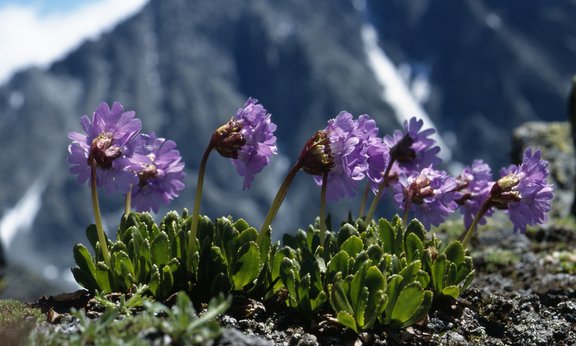Mountain plants are increasingly climbing towards the summits, because they now find the optimal temperature for growth at higher altitudes. Hence the colourful mountain dwellers are one of the most obvious indicators of current ecological changes in the high mountains, reports a team of ecologists from eleven countries in the latest issue of Nature. The study, led by Sonja Wipf (Swiss Federal Institute for Forest, Snow and Landscape Research) and Manuel Steinbauer (University of Erlangen-Nuremberg), also benefitted from substantial contributions by Austrian researchers from the Austrian Academy of Sciences, the University of Natural Resources and Life Sciences, Vienna, the University of Vienna and the University of Innsbruck.
Unique data comparison
The scientists analysed historical lists of plants from alpine summits from the nineteenth century which had been resurveyed in recent years, along with datasets from the worldwide monitoring programme GLORIA (Global Observation Research Initiative in Alpine Environments) initiated in the year 2000 and coordinated in Austria by the University of Natural Resources and Life Sciences and the Academy. Explaining the importance of this study, Harald Pauli of the Austrian Academy of Sciences emphasises: “Combining these data provided an internationally unique dataset enabling comparison of alpine vegetation development in times with lower and greater climate change”.
Europe-wide trend
There are several studies establishing the shift in the distribution range of species of alpine flora and fauna to higher altitudes. The new study, however, is the first to show the acceleration in this dynamic on a Europe-wide scale, manifested in an ever greater increase in species numbers in nine regions (Spitsbergen, Northern and Southern Scandinavia, Scotland, the High Tatras, the Eastern and Southern Carpathians, the Eastern and Western Alps and the Pyrenees). While on average only one new species per summit was observed in the period from 1957 to 1966, there were over five between 2007 and 2016.
The colonisation rate ran in parallel to the increase in temperatures over recent decades. “This points to human-made climate change as a driving factor, which is also confirmed by the above-average amount of thermophilic species among the newcomers,” explains researcher Manuela Winkler from the University of Natural Resources and Life Sciences.
Changes in precipitation rates or the anthropogenic nitrogen deposition might be significant on a regional level, but Europe-wide they do not show a clear correlation with the increase in the number of species at mountain summits. “Summit surfaces are mostly natural or semi-natural ecosystems. Hence human land use can hardly be considered responsible for this accelerated process,” says Brigitta Erschbamer of the University of Innsbruck.
Will this result in a decline in species diversity?
The consistent results shared across very different climatic zones give a strong indication of the large-scale impact of anthropogenic climate change on terrestrial ecosystems and the species composition of the semi-natural biosphere. “We see the net increase in species numbers as a transitional phase that could ultimately lead to the disappearance of many genuinely alpine species on the mountain summits,” fears Stefan Dullinger of the University of Vienna.
While the longevity of many species and their tolerance to climatic fluctuations may buffer against local processes of extinction, ultimately the highly accelerated shift in species increases the risk of biodiversity losses, especially when “tipping points” are reached, for instance by advancing shrub- and tree-lines.
Publication
Steinbauer, M.J. et al., “Accelerated increase in plant species richness on mountain summits is linked to warming”, Nature 2018.
DOI: 10.1038/s41586-018-0005-6
(Sven Hartwig/ÖAW)

